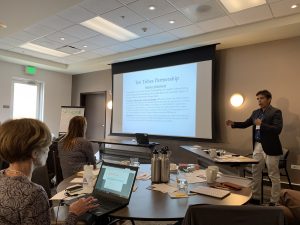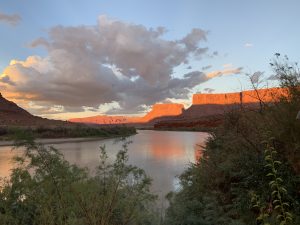Agriculture and Water: River Network Explores Water Transactions in the Western U.S.
 One of the things I’ve always found gratifying about working with rivers is the sense of common purpose I find with my colleagues. When we gather to learn from each other and trade ideas, I know that underneath all of the strategy and planning is the simple desire to share these amazing natural resources with future generations. So, while attending far away meetings for days at a time takes me from my home and family, it also puts me among friends and helps keep the passion for my work alive.
One of the things I’ve always found gratifying about working with rivers is the sense of common purpose I find with my colleagues. When we gather to learn from each other and trade ideas, I know that underneath all of the strategy and planning is the simple desire to share these amazing natural resources with future generations. So, while attending far away meetings for days at a time takes me from my home and family, it also puts me among friends and helps keep the passion for my work alive.
Last October, with support from the Walton Family Foundation, River Network gathered 30 stakeholders implementing environmental water transaction projects in the American West. Attendees arrived in the red rock canyons of Moab, Utah from a dozen different states to share successes and discuss the state of the practice.
In most western states, water is scarce and competition for it is abundant. Water to support a recreational economy or sustain river health is difficult to secure, and it’s often presented as a choice between watering crops, growing cities, or preserving the environment. But over those three days in Moab, those gathered discussed solutions that are win-win-win.
For example, switching crops can yield both water for the river’s environment and equal financial returns for area farmers. In Arizona’s Verde River Valley, The Nature Conservancy is working with farmers to shift from a traditional summer crop, such as alfalfa or corn, to a late winter/spring crop, such as barley. This shift results in less irrigation water diverted during the high-demand, low streamflow summer period. The result is more water in rivers for people and wildlife, a profitable crop for farmers, and a local source of barley for area microbreweries.
 Other win-win-win solutions include ranchers leasing their water on a voluntary, short-term basis to boost healthy river flows and water supply levels. In Utah’s Price River, Trout Unlimited worked with members of the Carbon Canal Company to enact a pilot project to irrigate for only part of their irrigation season. The 2,000 acre-feet of unused water was left in the stream and producers received payments for the temporary conservation use of that water.
Other win-win-win solutions include ranchers leasing their water on a voluntary, short-term basis to boost healthy river flows and water supply levels. In Utah’s Price River, Trout Unlimited worked with members of the Carbon Canal Company to enact a pilot project to irrigate for only part of their irrigation season. The 2,000 acre-feet of unused water was left in the stream and producers received payments for the temporary conservation use of that water.
River Network understands that maintaining healthy rivers in agricultural landscapes is a growing area of need for our members. Our recently released strategic plan presents this as a key issue area and calls for us to unite river and watershed conservation groups and water advocacy organizations with farmers and ranchers to find opportunities to scale or replicate successes.
The three days we spent in Moab last year is just one part of River Network’s engagement on agriculture. I hope you will join us at River Rally in Cleveland, Ohio this June as we spend a significant portion of River Rally exploring how our members work with farmers and ranchers to build thriving partnerships that result in improvements to water quality and river flows.
In the meantime, River Network is at work across the country to identify opportunities to increase the strength of our members and the power of our network to empower collective action. I look forward to spending quality time with many of you as we take time to shine a light on good work, remind each other of our shared purpose, and rekindle the energy that win-win solutions provide to our partnerships.





Hi – I wanted to check in and see if there might be any documentation available to the public from this meeting? I work on water supply projects and it seems like this meeting might be helpful in exploring alternatives to traditional reservoirs.
Thanks for your help.